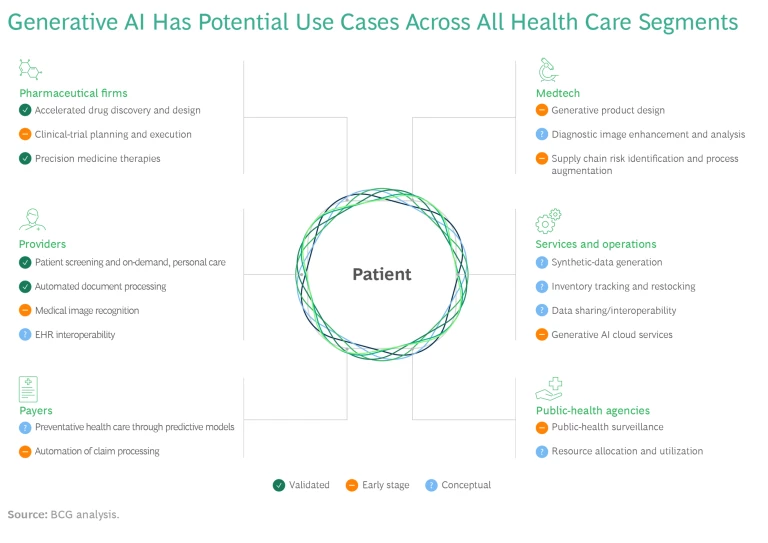Generative AI has quickly become a major factor in a number of industries, including health care. It has the potential to transform the sector, but executives must understand how to use the technology in order to capitalize on its potential while avoiding the risks inherent in applying it to patient care. We analyzed numerous use cases across health segments, looking at both solutions already on the market and those likely to arrive soon. Our goal was to demystify generative AI and help leadership teams make sense of the options.
Generative AI algorithms can analyze large volumes of medical data and create entirely new content. The technology can improve the quality of care, make it more accessible and affordable, reduce inequities in research and care delivery, and help companies
unlock value in new ways
. Moreover, generative AI overcomes some of the previous hurdles to AI adoption in health care. It requires less data, is more adaptable to unfamiliar situations, and can interface better with clinical staff. These features make generative AI more broadly applicable and transferable to different health care tasks.
Emerging Use Cases in Key Segments
Generative AI has potential use cases across the health care industry . (See the exhibit.) For each segment—providers, pharmaceutical firms, payers, medtech, services and operations, and public-health agencies—we grouped the options into three categories: validated solutions already on the market, early-stage or conceptual use cases, and potential future use cases not yet in development.

Providers
Several generative AI providers are developing solutions—from diagnosis to care provision to patient monitoring—to help providers improve clinical outcomes. Others are working to improve resource utilization by both clinical and administrative staff.
Validated Products in Use Today. Paige.AI, a digital pathology company, is integrating generative AI into its products to improve the accuracy and efficiency of prostate cancer detection. It was the first company to receive FDA approval for AI use in digital pathology and is looking to integrate the resulting information into patient electronic health records along with other clinical data.
On the administrative front, Doximity, Abridge, and DeepScribe are exploring applications that automate processes such as documentation, claims handling, preauthorization and appeals, patient onboarding, and scheduling. DeepScribe, which offers AI scribing services, has been able to decrease the amount of time providers spend on administrative tasks by three hours each day, and Abridge’s ambient AI scribing products are now in use at more than 140 provider locations in the University of Kansas Health System.
Early-Stage/Conceptual Use Cases. To aid caregivers, some providers are developing digital solutions that patients interact with directly. For example, Babylon Health has created a digital health service that uses generative AI to understand patients’ evolving risk profile, helping providers offer more personalized care at lower cost. A generative AI-powered counseling chatbot available on demand from Serena delivers accessible and affordable mental health care.
Potential Future Use Cases. In the future, generative AI could support real-time patient monitoring, along with data analysis to generate personalized insights that encourage healthy behaviors or lead to timely interventions before medical conditions worsen. Generative AI could also make imaging solutions more accurate and transferable across different practice areas. Finally, the technology’s adaptability and interactivity could encourage preventive care, wellness, and healthy behaviors via personalized nudges on mobile apps, wearables, and monitoring devices.
Pharmaceutical Firms
Generative AI is accelerating drug discovery, improving clinical-trial planning and execution, and leading to more precision medicine therapies.
Validated Products in Use Today. Generative AI allowed Insilico Medicine to go from novel-target discovery to preclinical candidate in just 18 months, spending only $2.6 million. The company’s idiopathic pulmonary fibrosis drug recently received the agency’s Orphan Drug Designation after completing the preclinical phase in 30 months, much faster than average for a new treatment.
Generative AI is accelerating drug discovery, improving clinical-trial planning and execution, and leading to more precision medicine therapies.
The biotech company Exscientia is using generative AI to analyze patient tissue and employ functional precision oncology to improve patient outcomes. NVIDIA is offering a set of generative AI cloud services that enable customization of AI foundation models to accelerate drug discovery and research in genomics, chemistry, biology, and molecular dynamics. The services provide pretrained models and enable researchers to fine-tune generative AI applications on their own proprietary data. The offering has been adopted by drug discovery startups such as Evozyne and Insilico Medicine, as well as by incumbents such as Amgen.
Early-Stage/Conceptual Use Cases. Several biotech firms are at an earlier stage of generative AI exploration:
- Ordaōs is developing a class of miniproteins with enhanced biological and therapeutic attributes to treat uniquely challenging rare cancers that primarily afflict ethnic minorities..
- Absci is using deep-learning AI and synthetic biology to design new antibodies against cancers and immune diseases.
- Profluent created a machine-learning model able to generate new protein sequences with specific functions, an innovative tool that can help improve access to affordable treatments.
Beyond drug discovery, generative AI could accelerate and improve clinical trials and precision medicine therapies. For example, digital modeling of clinical trials—including synthetic control groups—has recently been validated. Similarly, a tool developed by Synthesized can help researchers expand existing drugs beyond their initial use to treat other diseases, which could make medicines more accessible.
Potential Future Use Cases. Looking ahead, the use of generative AI at the preclinical and clinical stage could accelerate access to therapeutics, even for rare conditions whose treatment development has been difficult or economically prohibitive. The technology may be also used in the analysis of patient data to identify subgroups likely to respond to specific treatments or to personalize drugs to the unique needs of individual patients.
Payers
Payers are starting to leverage generative AI to reduce costs and improve risk management and member engagement, with the overall goal of offering higher-quality coverage at less cost to consumers.
Validated Products in Use Today. DigitalOwl is automating much of the underwriting and claims management process, reducing operating expenses and turnaround times to boost affordability.
Early-Stage/Conceptual Use Cases. Companies like ConcertAI are developing predictive models to identify and proactively manage high-risk segments based on patient medical history and demographic and social determinants of health.
Payers are starting to leverage generative AI to reduce costs and improve risk management and member engagement.
Potential Future Use Cases. Generative AI could support applications like conversational AI to deliver personalized messages based on member health needs and preferences.
Medtech
Generative AI could help companies create more personalized and patient-centered devices—incorporating software that allows for preventive maintenance and repairs, for example.
Early-Stage/Conceptual Use Cases. The UK ’s National Centre for Additive Manufacturing is applying generative AI to optimize the design of medical devices such as prosthetics and implants, tailoring them to the needs of individual patients. And medtech company Implicity is using the technology to incorporate remote monitoring in pacemakers and implantable defibrillators.
In brain health, DiagnaMed recently announced the development of a platform leveraging generative AI to analyze electroencephalography signals in order to predict and monitor brain aging and provide insights and tools in the diagnosis, prevention, or mitigation of cognitive decline in patients with mental health and neurodegenerative disorders.
Activ Surgical, a digital-surgery pioneer, recently announced completion of its first AI-enabled case, which provides enhanced visualization and real-time, on-demand surgical insights inside the operating room.
Potential Future Use Cases. Future applications could enable companies to collect and analyze data via remote-monitoring systems, leading to more effective patient interventions. Quality control applications could predict when devices and equipment may need repairs, allowing caregivers to schedule maintenance and reduce downtime.
Services and Operations
In health care services, generative AI can be particularly useful in data analytics and software optimization. Because it is more flexible than earlier generations of AI and can accommodate different data modes and formats—and even generate synthetic data to complement insufficient data sets—generative AI can improve the interoperability of existing applications, including health and laboratory information management systems.
Early-Stage/Conceptual Use Cases. Syntegra and Google’s EHR-Safe are creating machine-learning models that generate synthetic health care data sets, enabling fast and easy access to flexible longitudinal data that (with adequate privacy protections) can help public-health programs make more informed decisions.
In health care services, generative AI can be particularly useful in data analytics and software optimization.
Potential Future Use Cases. Future applications could help health systems in areas such as inventory tracking and restocking, cold-chain logistics, data sharing, and HR functions (including recruitment and training). Additionally, generative AI could help personalize and automate corporate functions, with potential use cases such as generative AI-enabled office applications, auto-generated knowledge management, and human-machine interaction assistance.
Public-Health Agencies
Public-health agencies, other health organizations, and government ministries could leverage generative AI to improve resource planning and allocation, anticipate public-health needs and interventions, and execute programs more effectively.
Early-Stage/Conceptual Use Cases. BioNTech recently acquired InstaDeep in order to develop an early-warning system for new COVID-19 variants. Structural modeling of the SARS-CoV-2 protein combined with InstaDeep’s generative AI capabilities allows the system to proactively alert researchers, vaccine developers, health authorities, and policymakers.
Potential Future Use Cases. Going forward, generative AI-powered tools could be used to monitor public health and allocate resources. In the US, Medicaid could potentially leverage the technology to better manage allocations based on health data and forecasted need. The FDA could use it when reviewing the safety and efficacy of drugs, and generative AI could help public-health groups like Doctors Without Borders predict outbreaks and mobilize resources to minimize impact.
Managing Potential Risks
Although generative AI technology is promising, some near-term caution is warranted. There are several
inherent risks
that providers must address before broad adoption in health care can occur.
- Biased Outputs. Generative AI results can reflect inherent biases in the underlying data. In response, generative AI companies need to assign experts to review the data and results and correct for bias through oversampling and other statistical techniques.
- False Results. Because the models are still evolving, they can sometimes generate results that are simply wrong (a phenomenon in AI known as hallucinating). Providers will need to make their models more transparent and emphasize the need for human review of outputs.
- Patient Privacy. Patient health data is sensitive and needs to be handled with extreme care. Companies with generative AI solutions should clarify data ownership with partners, strengthen cybersecurity, and look beyond existing data to the development of synthetic data.
- Opaque Results. A challenge with generative AI is that it operates as a black box, making it unsettling to some users. To build trust and increase adoption rates, health care organizations will need to explain how a given algorithm works and how a specific set of data leads to a prognosis.
- Misuse or Overreliance. Patients may rely too heavily on information from generative AI. Hospitals, clinicians, and payers should clarify how specific solutions should be used, with clear messaging that AI-generated insights are recommendations rather than mandates.
How to Get Started
Even as the range of generative AI applications continues to expand, incumbent health organizations can create the right foundation for adoption and implementation.
- Create an enterprise-wide generative AI strategy. Explore new offerings and business models with generative AI.
- Build data systems. Invest in data management and analysis tools to leverage large and mixed data sets.
- Invest in capabilities. Recruit in-house experts to advise, implement, and monitor generative AI opportunities and train key stakeholders in using the technology to make informed decisions.
- Forge strategic partnerships. Partner with tech players and consulting firms to bring in timely and best-in-class external assets and expertise.
- Integrate with the broader ecosystem. Establish data interoperability, offerings, and systems foundational for generative AI. Ensure close coordination with regulatory agencies to co-develop effective and safe solutions.
Generative AI involves uncertainties and risks, but it also holds the potential to dramatically increase efficiency, improve the quality of care, and create value for health care organizations. For that reason, leaders need to plot a path to capitalize on the technology—starting today.











